Griffith
With the streak of a tear, Like morning dew
This reference was compiled from information provided in the back of Viz Media's editions of Vagabond and from Viz's, now defunct, Vagabond website. As far as we know, this information isn't compiled altogether like this anywhere else, even in Viz Media's official Vagabond section. Therefore, the Vagabond Inn is happy to provide this information in its entirety here, broken down into six sections:
I. About the Author
II. About Vagabond and Miyamoto Musashi
III. Characters
IV. Glossary and Extraneous Background Information
V. Awards
VI. What the critics are saying about Vagabond
I. About the Author
II. About Vagabond and Miyamoto Musashi
Takehiko Inoue’s Vagabond, based on Eiji Yoshikawa’s novel Musashi, is a fictional account of the life of Miyamoto Musashi (1584-1645). The historical figure Miyamoto Musashi, author of the philosophical strategy guide A Book of Five Rings, was a master of the sword and was revered as a “sword-saint.” He founded the Ninten Ichi style of sword fighting, which is typified by fighting with both long and short swords simultaneously—holding the long sword with the right hand and the short sword with the left. Musashi was also a master of the “gentler arts”—he was a master sumi-e (black in drawings), metalworking, and woodcarving. The films that comprise The Samurai Trilogy, directed by Hiroshi Inagaki and starring Toshiro Mifune, were also based on Yoshikawa’s Musashi. Inspired by the huge success of Vagabond in Japan, in 2003 NHK produced the historical period drama Musashi. Also based on Yoshikawa’s novel, this drama stars kabuki actor Shinnosuke Ichikawa as Musashi and TV star Ryoko Yonekura as Otsu.
Vagabond has been printed to read from right to left in its original Japanese format—presenting Takehiko Inoue’s dynamic artwork the way it was meant to be seen!
When most Japanese comics are published in English, a mirror image of the original artwork is printed in order to accommodate the left to right reading orientation of English. For this reason, errors in continuity occasionally occur and characters who were originally right-handed suddenly become left-handed. In order to present manga in its purist form, Vagabond is being printed to read from right to left. This way, kimono are worn with the left side over the right and the samurai’s long and short swords are carried on the left side, the way they were traditionally worn.
To properly enjoy Vagabond, start from the other end of this comic and read from right to left.
A note on names:
The names presented in the context of this manga are presented in the traditional Japanese order—surname followed by first name. “Miyamoto” is Miyamoto Musashi’s last name and “Musashi” is his first name. The name of the creator of Vagabond, however, has been presented first name first, last name second. “Takehiko” is the author’s first name and “Inoue” is his last name.
III. Characters
IV. Glossary and Extraneous Background Information
A Brief Historical Overview - The Sengoku Period and the Battle of Sekigahara
The Sengoku (warring states) period (1482-1558) in Japan was a time of chaos and conflict. Central authorities, in the form of the imperial court and the shogunate, had grown increasingly weak and land was effectively rules autonomously by numerous daimyo (domainal lords). Looking to expand their spheres of control, the daimyo were constantly at war with each other. One daimyo in particular, Oda Nobunaga, set out on a mission to unify Japan by means of conquest. Incredibly successful, by the time of his assassination in 1582, he managed to control approximately one-third of Japan. One of Nobunaga’s chief generals, Toyotomi Hideyoshi, became Nobunaga’s successor to carry on the quest for unification. Through a process of conquest and conciliation, Hideyoshi succeeded in creating an orderly federation amongst the daimyo, and by 1590, order was restored to Japan under Hideyoshi’s rule. Hideyoshi’s death in 1598, however, presented the question of succession. Most of the daimyo from the domains in the west remained loyal to the Toyotomi Clan and its 5-year-old heir, Toyotomi Hideyori. Tokugawa Ieyasu, however, leading the major daimyo from central and eastern Japan, challenged the Toyatomi clan’s leadership. The two sides clashed at the Battle of Sekigahara (1600) in Mino (located in present day Gifu Prefecture) where the Tokugawa claimed an overwhelming victory. From that point on, the Tokugawa clan would effectively rule Japan for the next 250 years. The political stability that resulted put mass numbers of samurai out of work. Masterless samurai, known as ronin, were forced to wander the land and seek out employment. This, the beginning of the Edo period (1600-1868), set the stage for many of the period dramas and chambara sword-fighting films that have popularized the image of the samurai to a Western audience.
The Battle Sekigahara (1600)
The decisive battle in which Tokugawa Ieyasu effectively took control of Japan from the Toyotomi Clan. Most of the daimyo of the west sided with the Toyotomi Clan. In the opening of Vagabond, we find Takezo and Matahatchi as young survivers on the losing side of the Battle of Sekigahara…
Echizen
Located in the northern part of present-day Fukui Prefecture.
Eiroku
Name of the era from 1558 to 1569.
Higo
Located in modern day Kumamoto Prefecture.
Hon’ami Koetsu (1558-1636)
Famed artist and calligrapher who co-founded an influential arts movement called the Rinpa School. Koetsu was involved in numerous fields including tea ceremony, potter, and calligraphy. In addition, Koetsu succeeded the line of his family’s ancestral business of sword polishing and appraisals.
Hozoin Spear Technique
Created by the Buddhist monk Kakuzenbo Hoin In’ei (1521-1607) of Hozoin Temple, which was a sub-temple of Kokufuji Temple in Nara. This spear technique is typified by quick dexterous movements rather than the use of brute force.
Ikeda Terumasa (1564-1613)
One of the great daimyo of the Sengoku period (1482-1558), Ikeda Terumasa sided with Ieyasu at the Battle of Sekigahara after which he was awarded with Himeji Castle and the Harima domain (located in modern day Hyogo Prefecture).
Ito Ittosai (Dates unknown)
Founder of the Itto-ryu school, one of the largest schools of sword fighting. Before establishing his own style, Ittosai is said to have studied a variant of the Chujo-ryo style of sword fighting under Kanemaki Jisai’s instruction.
Kaga
Located in present day Ishikawa Prefecture.
Kami’izumi Ise no Kami Hidetsuna (1508-1577(?))
The son of Kami-izumi Ise no Kami Hidetsugu, the lord of Kami’izumi Castle in present-day Gunma Prefecture. Hidetsuna founded the Shinkage-ryu Style of sword fighting, and was such and accomplished swordsman and military strategist that he was once recruited by the famed Takeda Shingen. Hidetsuna, however, declined the post, stating that he preferred to travel throughout the land so that he might perfect his swordsmanship. Many notable figures studied under Hidetsuna, including the esteemed Yagyu Munenori of and Hozoin In’ei.
Kiku-ichimonji
Swords created by swordsmiths specifically authorized by Emperor Gotoba in the early 13th century. The tangs of these exceptional quality swords were inscribed with the imperial city chrysanthemum crest together with the characters for the numeral one.
Kitabatake Tomonori (1528-1576)
Ruler of Ise, which is located in the Mie Prefecture. Tomonori is also said to have been a master of the Kashima Shinto Ryu.
koku
Approximately 5.1 U.S. bushels or 180.39 liters. Samurai were paid their stipends in bushels of rice. One koku was a standard measure representing the approximate amount of rice necessary to feed one man for a year.
Konpukuji
Located in the northeastern part of Kyoto, Konpukuji Temple is small temple of the Rinzai School of Zen Buddhism.
Kyoto Shoshidai
An administrative appointment which served to govern the populace of Kyoto and to keep a watch on the daimyo in the west.
Muso Gonnosuke (dates unknown)
Founder of the Shinto Muso-ryu school of martial arts, which mainly utilized the wooden staff. Gonnosuke is said to have been one of the many to lose to Musashi in a duel. According to some accounts he defeated Musashi in a rematch.
Owari
Located in modern day Nagoya and its surrounding area.
Rengeoin
Located in Eastern Kyoto, Rengeoin Temple, a part of the Tendai School of Buddhism, is more commonly referred to as Sanjusangendo. The main hall of Rengeoin features an amazing display of 1,001 Kannon Buddhist statues.
Sakushu
Also known as Mimasaka. The historical name for the area that is now the northern region of modern-day Okayama Prefecture.
Sangen’in Temple
One of the main subtemples of Daitokuji Temple in Kyoto.
Sasaki Kojiro (dates unknown)
The legendary archrival of Miyamoto Musashi, Kojiro is believed to have studied the Chujo-ryu style of swordsmanship under the instruction of either Toda Seigen or Kanemaki Jisai. Kojiro was renowned for his Tsubame-gaeshi, or “swallow cut” technique which was inspired by the movement of a swallow in flight.
Shinmen Takezo
Miyamoto Musashi’s boyhood name.
Sottaku
A zen term used to describe a disciple and his master in perfect sync when the time is right for the disciple to awaken to enlightenment.
Takuan Soho (1573-1645)
A monk of the Rinzai sect of Zen Buddhism, by the time Takuan was 37, he was appointed abbot of the leading temple of the Rinzai sect, Daitokuji. Takuan was an important figure whose acute and brutally honest advice was sought by influential and powerful figures such as Emperor Go Mizuno and the shogun Tokugawa Iemitsu. His correspondence to Yagyu Munenori discussing Zen and swordsmanship entitled The Unfettered Mind has become an influential treatise in both the areas of philosophy and martial arts. The pickled daikon radish, takuan, also bears his name.
Tsukahara Bokuden (1489-1571)
Founder of the Kashima Shinto Ryu style of sword fighting. Bokuden was from the city of Kashima in modern day Ibarki Prefecture and is famous for his sword training pilgrimages, which took him on travels throughout Japan.
Ukita Hidele (1573-1655)
Daimyo of Bizen and Mimasaka (located in modern day Okayama Prefecture). One of the leading generals that fought for the Toyotomi Clan at the Batlle of Sekigahara.
The Yagyu Clan
Yagyu Muneyoshi Sekishusai (1527-1606) was the founder of the Yagyu-Shinkage school of sword fighting. His son Yagyu Munenori (1571-1646) was one of Tokugawa’s key generals at the Battle of Sekigahara. Munenori was appointed the official fencing instructor of the Tokugawa Clan, and in 1632 the Yagyu were appointed the ometsuke—responsible for the survielence of the daimyo. Although the Yagyu can has been depicted in Kazuo Koike’s Lone Wolf and Cub as the plotters of the downfall of Itto Ogami, the general Japanese popular culture take on the Yagyu Clan is more positive. Specifically, Munenori’s son, Yagyu Jubei (1607-1650), is viewed as a wandering hero protecting the people from evildoers.
The Yoshioka Clan
Yoshioka Kempo (dates unknown) was a distinguished warrior from the Sengoku period (1482-1558) and founder of the renowned Yoshioka school of sword fighting. Yoshioka Kempo mastered the Kyohachi style of swordsmanship and then modified it to form the Yoshioka style. In the context of Inoue’s Vagabond, as well as Yoshikawa’s Musashi, Yoshioka Seijuro and Denshichiro are Kempo’s sons, who are historically thought to have dueled with Miyamoto Musashi on numerous occasions.
V. Awards
Winner of the 2000 Media Arts Festival Award from the Japanese Ministry of Culture
Recipient of the 2000 Kodansha Award for Best Manga
Winner of the 2002 Tezuka Osamu Cultural Award
Nominated for a 2003 Eisner Award for Best Writer/Artist
VI. What the critics are saying about Vagabond
This beautifully drawn series has incredible action, a hint of romance, and a strong core of Japanese history…this book now has the possibility of taking off like a rocket with the American audience.
--Troy Brownfield, Shotgun Reviews
A fierce tone of action is set with stunning visuals and adept characterization. Inoue is obviously a skilled storyteller, and [the] first two issues only make me want more. That's definitely something American comics could learn from.
--Troy Brownfield, Shotgun Reviews
Inoue's art style is wonderfully smooth and expressive. Forget all the obvious things that Inoue does so well, like facial expressions and easy-to-follow battle scenes; it's stuff like this that shows Inoue's mastery of his craft. I was entranced within pages of reading Vagabond; Inoue's adaptation of Yoshikawa's Musashi pulls you right into the story and doesn't let you go.
--Greg McElhatton, iComics.com
Inoue’s artwork is flat-out gorgeous, whether it’s in the brief color sections or in black and white. There is a stunning amount of detail in the backgrounds and in the character designs, and it’s clear that there has been a lot of research into the costumes, weapons, and settings of the era.
--Randy Lander, TheFourthRail.com
Inoue's art in this book is remarkably detailed and realistic, while still maintaining that uniquely manga tone.
--Don MacPherson, TheFourthRail.com
It is a masterwork in story and art. In no time you are drawn into the characters, first by the skillful art and then by the story. I found Takehiko's art most appealing and his storytelling ability superb. If you are already a fan of the comics from Viz this will be a must buy. If you have not tried any, this would be a good first venture. I think you will want to stay for the long run.
--David LeBlanc, Comic Book Net Electronic Magazine
If you’re interested in Japanese culture, this is a must-buy for you. The story is fast-paced; the artwork is a feast for the eyes…This is one of the best works of historical fiction I’ve ever read....
--Patrick King, animefringe.com
...this reads like an Akira Kurosawa film captured on the printed page. Takehiko Inoue’s fine line art, much more detailed for the norm for Japanese manga, is a real treat, while the storyline captivates.
--Cliff Biggers, Comics Buyer’s Guide
Takehiko Inoue’s vibrant postmodern spin on the (samurai) genre is topnotch in every respect.
--S.A. Bennett, Comics Buyer’s Guide
What makes Vagabond stand out, and makes this something more than just a retelling of Musashi’s life is Inoue’s feel for the characters, breathing life into figures who lived in a world so long ago and so far away.
--Matt Brady, Newsarama
Inoue masterfully portrays the brutality of Vagabond’s setting and the interactions of the characters…Inoue can surprise and even shock the reader with the turns his story and their lives can take. Combined with the often breathtaking art, this makes for an extremely satisfying comics experience.
--Tony Isabella, Comics Buyer’s Guide
I think this manga has something for everyone. A MUST READ!
--Phoenix, MangaManiacs.org
An excellent manga, presented with noticeable care… If you’re a fan of Japanese history, you need this in your library. It’s that good.
--Patrick King, animefringe.com
…Inoue’s skills as a comics creator makes Vagabond outstanding. This is really one of the best comics currently being produced. I buy every book as soon as it’s published and once you take a look yourself, you’ll do the same.
--Greg McElhatton, icomics.com
Vagabond is a must for fans.
--Scott Green, Ain't It Cool News
Some of the most beautiful pen-and-ink work in any comic being published now.
--Adi Tantimedh, ArtBomb
Viz is giving readers a lot of bang for their comic buck with this one. Inoue's heavy, dark style...emphasizes the realism of the story, and the weight and realness of the characters. Nor does he ever lose control of it. His attention to detail is extraordinary.
--Dani Fletcher, SequentialTart.com
Flawless artistic storytelling.
--Kai-Ming Cha, Publishers Weekly
More than just flesh-splitting battle scenes and mandala-like sequences of spiritual introspection, Vagabond seems to contain the entire world and span the entire human condition.
--Jason Thomson, Manga: The Complete Guide
Vagabond has its own unique look and feel that distinctively separates it from the pack...this is the author's best work to date.
--Tokyo Drifter, GamePro.com
I. About the Author
II. About Vagabond and Miyamoto Musashi
III. Characters
IV. Glossary and Extraneous Background Information
V. Awards
VI. What the critics are saying about Vagabond
I. About the Author
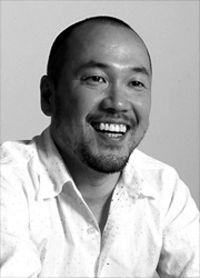
| Vagabond was created by author and artist Takehiko Inoue, born in Kagoshima prefecture in 1967. His first major success--the hugely popular 31-volume long basketball manga Slam Dunk--sold over 100 million copies worldwide and catapulted him into the top ranks of Japanese manga artists. Since its release, every tankoban (Japanese graphic novel) of Vagabond has been on the top ten best seller's lists in Japan with over 22 million volumes in print. Critically acclaimed, Inoue received the 2000 Media Arts Award for manga from the Japanese Ministry of Culture as well as the 2000 Kodansha Award for best manga for his work on Vagabond. In 2002, Vagabond received the prestigious Tezuka Award for best manga, and in 2003, Inoue was nominated for a 2003 Eisner award for best writer/artist. While Vagabond continues its epic run in Japan, Inoue is simultaneously pushing the bounds of manga narrative with Real—a heavy-hitting manga about wheelchair basketball. To date Vagabond has sold over 40 million copies throughout the world. In addition to his numerous manga titles, Inoue also created the character designs for the PlayStation basketball game, One on One. "I'm creating this character for the modern reader." -Inoue Takehiko on Miyamoto Musashi |
II. About Vagabond and Miyamoto Musashi
Takehiko Inoue’s Vagabond, based on Eiji Yoshikawa’s novel Musashi, is a fictional account of the life of Miyamoto Musashi (1584-1645). The historical figure Miyamoto Musashi, author of the philosophical strategy guide A Book of Five Rings, was a master of the sword and was revered as a “sword-saint.” He founded the Ninten Ichi style of sword fighting, which is typified by fighting with both long and short swords simultaneously—holding the long sword with the right hand and the short sword with the left. Musashi was also a master of the “gentler arts”—he was a master sumi-e (black in drawings), metalworking, and woodcarving. The films that comprise The Samurai Trilogy, directed by Hiroshi Inagaki and starring Toshiro Mifune, were also based on Yoshikawa’s Musashi. Inspired by the huge success of Vagabond in Japan, in 2003 NHK produced the historical period drama Musashi. Also based on Yoshikawa’s novel, this drama stars kabuki actor Shinnosuke Ichikawa as Musashi and TV star Ryoko Yonekura as Otsu.
Vagabond has been printed to read from right to left in its original Japanese format—presenting Takehiko Inoue’s dynamic artwork the way it was meant to be seen!
When most Japanese comics are published in English, a mirror image of the original artwork is printed in order to accommodate the left to right reading orientation of English. For this reason, errors in continuity occasionally occur and characters who were originally right-handed suddenly become left-handed. In order to present manga in its purist form, Vagabond is being printed to read from right to left. This way, kimono are worn with the left side over the right and the samurai’s long and short swords are carried on the left side, the way they were traditionally worn.
To properly enjoy Vagabond, start from the other end of this comic and read from right to left.
A note on names:
The names presented in the context of this manga are presented in the traditional Japanese order—surname followed by first name. “Miyamoto” is Miyamoto Musashi’s last name and “Musashi” is his first name. The name of the creator of Vagabond, however, has been presented first name first, last name second. “Takehiko” is the author’s first name and “Inoue” is his last name.
III. Characters
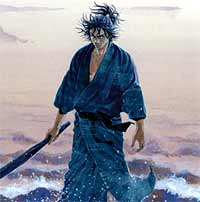
| Takezo/Musashi One of the only young survivors of the Battle of Sekighara, Takezo is a lone warrior determined to survive and sharpen his skills as a samurai by challenging master swordsmen throughout Japan to find the height of his strength. A wild loner since his youth, Takezo must fight both mental and physical battles as he comes to terms with his reputation as a wild beast and his desire to survive, while fighting off those determined to kill him. Takezo eventually changes his name and outlook on life as he continues his quest to become a master swordsman under the name Miyamoto Musashi. |
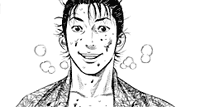
| Matahachi Takezo's friend and fellow warrior, Matahachi struggles with his image in Takezo's shadow, both on the battlefield and in the hearts of those around him. Engaged to Otsu before the war, Matahachi abandons both his family and his promises when he falls in love with Oko and decides to remain with her, rather than returning home. |

| Takuan A Zen monk, who acts as a guide to Takezo as he transforms into Miyamoto Musashi, this character is based on the real-life Takuan Soho (1573-1645). A monk of the Rinzai sect of Zen Buddhism, by the time Takuan was 37, he was appointed abbot of the leading temple of the Rinzai sect, Daitokuji. Takuan was an important figure whose acute and brutally honest advice was sought by influential and powerful figures including Go Mizuno and Tokugawa lemitsu. His correspondence to Yagyu Munenori, discussing Zen and swordsmanship entitled The Unfettered Mind, has become an influential treatise in both the areas of philosophy and martial arts. The pickled daikon radish, takuan, also bears his name. |
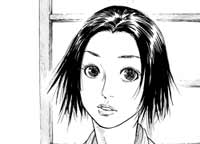
| Otsu An orphan engaged to Matahachi, Otsu is left to mourn his absence when he takes up with another woman. A kind, gentle woman, Otsu must fight the advances of other suitors and define her loyalties to Takezo, while shaping her new future without Matahachi. |
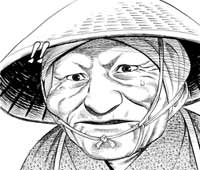
| Granny Matahachi's mother, Granny has a strong work ethic that reflects her determination to wait for her son's return. Convinced that her son is still alive and was dragged to war by Takezo, Granny will do anything to anyone to preserve her son's honor, even if it means destroying Takezo in the process. |
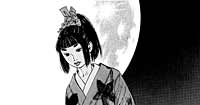
| Akemi After finding Takezo and Matahachi on the battlefield, Akemi and her mother tend to their wounds. Longing for her father, who was killed by a local gang leader, Akemi and her mother make their living by robbing dead soldiers after battle and selling anything they can find. |
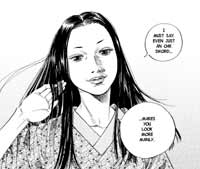
| Oko Akemi's mother, Oko has struggled to raise her daughter and protect her home since the death of her husband. Drawn to Takezo, Oko instead attracts the affection of Matahachi, causing him to abandon his fiancÈe and family in order to stay with and protect her from local gangs that are attracted to both her beauty and the riches she finds on battlefields. |
IV. Glossary and Extraneous Background Information
A Brief Historical Overview - The Sengoku Period and the Battle of Sekigahara
The Sengoku (warring states) period (1482-1558) in Japan was a time of chaos and conflict. Central authorities, in the form of the imperial court and the shogunate, had grown increasingly weak and land was effectively rules autonomously by numerous daimyo (domainal lords). Looking to expand their spheres of control, the daimyo were constantly at war with each other. One daimyo in particular, Oda Nobunaga, set out on a mission to unify Japan by means of conquest. Incredibly successful, by the time of his assassination in 1582, he managed to control approximately one-third of Japan. One of Nobunaga’s chief generals, Toyotomi Hideyoshi, became Nobunaga’s successor to carry on the quest for unification. Through a process of conquest and conciliation, Hideyoshi succeeded in creating an orderly federation amongst the daimyo, and by 1590, order was restored to Japan under Hideyoshi’s rule. Hideyoshi’s death in 1598, however, presented the question of succession. Most of the daimyo from the domains in the west remained loyal to the Toyotomi Clan and its 5-year-old heir, Toyotomi Hideyori. Tokugawa Ieyasu, however, leading the major daimyo from central and eastern Japan, challenged the Toyatomi clan’s leadership. The two sides clashed at the Battle of Sekigahara (1600) in Mino (located in present day Gifu Prefecture) where the Tokugawa claimed an overwhelming victory. From that point on, the Tokugawa clan would effectively rule Japan for the next 250 years. The political stability that resulted put mass numbers of samurai out of work. Masterless samurai, known as ronin, were forced to wander the land and seek out employment. This, the beginning of the Edo period (1600-1868), set the stage for many of the period dramas and chambara sword-fighting films that have popularized the image of the samurai to a Western audience.
The Battle Sekigahara (1600)
The decisive battle in which Tokugawa Ieyasu effectively took control of Japan from the Toyotomi Clan. Most of the daimyo of the west sided with the Toyotomi Clan. In the opening of Vagabond, we find Takezo and Matahatchi as young survivers on the losing side of the Battle of Sekigahara…
Echizen
Located in the northern part of present-day Fukui Prefecture.
Eiroku
Name of the era from 1558 to 1569.
Higo
Located in modern day Kumamoto Prefecture.
Hon’ami Koetsu (1558-1636)
Famed artist and calligrapher who co-founded an influential arts movement called the Rinpa School. Koetsu was involved in numerous fields including tea ceremony, potter, and calligraphy. In addition, Koetsu succeeded the line of his family’s ancestral business of sword polishing and appraisals.
Hozoin Spear Technique
Created by the Buddhist monk Kakuzenbo Hoin In’ei (1521-1607) of Hozoin Temple, which was a sub-temple of Kokufuji Temple in Nara. This spear technique is typified by quick dexterous movements rather than the use of brute force.
Ikeda Terumasa (1564-1613)
One of the great daimyo of the Sengoku period (1482-1558), Ikeda Terumasa sided with Ieyasu at the Battle of Sekigahara after which he was awarded with Himeji Castle and the Harima domain (located in modern day Hyogo Prefecture).
Ito Ittosai (Dates unknown)
Founder of the Itto-ryu school, one of the largest schools of sword fighting. Before establishing his own style, Ittosai is said to have studied a variant of the Chujo-ryo style of sword fighting under Kanemaki Jisai’s instruction.
Kaga
Located in present day Ishikawa Prefecture.
Kami’izumi Ise no Kami Hidetsuna (1508-1577(?))
The son of Kami-izumi Ise no Kami Hidetsugu, the lord of Kami’izumi Castle in present-day Gunma Prefecture. Hidetsuna founded the Shinkage-ryu Style of sword fighting, and was such and accomplished swordsman and military strategist that he was once recruited by the famed Takeda Shingen. Hidetsuna, however, declined the post, stating that he preferred to travel throughout the land so that he might perfect his swordsmanship. Many notable figures studied under Hidetsuna, including the esteemed Yagyu Munenori of and Hozoin In’ei.
Kiku-ichimonji
Swords created by swordsmiths specifically authorized by Emperor Gotoba in the early 13th century. The tangs of these exceptional quality swords were inscribed with the imperial city chrysanthemum crest together with the characters for the numeral one.
Kitabatake Tomonori (1528-1576)
Ruler of Ise, which is located in the Mie Prefecture. Tomonori is also said to have been a master of the Kashima Shinto Ryu.
koku
Approximately 5.1 U.S. bushels or 180.39 liters. Samurai were paid their stipends in bushels of rice. One koku was a standard measure representing the approximate amount of rice necessary to feed one man for a year.
Konpukuji
Located in the northeastern part of Kyoto, Konpukuji Temple is small temple of the Rinzai School of Zen Buddhism.
Kyoto Shoshidai
An administrative appointment which served to govern the populace of Kyoto and to keep a watch on the daimyo in the west.
Muso Gonnosuke (dates unknown)
Founder of the Shinto Muso-ryu school of martial arts, which mainly utilized the wooden staff. Gonnosuke is said to have been one of the many to lose to Musashi in a duel. According to some accounts he defeated Musashi in a rematch.
Owari
Located in modern day Nagoya and its surrounding area.
Rengeoin
Located in Eastern Kyoto, Rengeoin Temple, a part of the Tendai School of Buddhism, is more commonly referred to as Sanjusangendo. The main hall of Rengeoin features an amazing display of 1,001 Kannon Buddhist statues.
Sakushu
Also known as Mimasaka. The historical name for the area that is now the northern region of modern-day Okayama Prefecture.
Sangen’in Temple
One of the main subtemples of Daitokuji Temple in Kyoto.
Sasaki Kojiro (dates unknown)
The legendary archrival of Miyamoto Musashi, Kojiro is believed to have studied the Chujo-ryu style of swordsmanship under the instruction of either Toda Seigen or Kanemaki Jisai. Kojiro was renowned for his Tsubame-gaeshi, or “swallow cut” technique which was inspired by the movement of a swallow in flight.
Shinmen Takezo
Miyamoto Musashi’s boyhood name.
Sottaku
A zen term used to describe a disciple and his master in perfect sync when the time is right for the disciple to awaken to enlightenment.
Takuan Soho (1573-1645)
A monk of the Rinzai sect of Zen Buddhism, by the time Takuan was 37, he was appointed abbot of the leading temple of the Rinzai sect, Daitokuji. Takuan was an important figure whose acute and brutally honest advice was sought by influential and powerful figures such as Emperor Go Mizuno and the shogun Tokugawa Iemitsu. His correspondence to Yagyu Munenori discussing Zen and swordsmanship entitled The Unfettered Mind has become an influential treatise in both the areas of philosophy and martial arts. The pickled daikon radish, takuan, also bears his name.
Tsukahara Bokuden (1489-1571)
Founder of the Kashima Shinto Ryu style of sword fighting. Bokuden was from the city of Kashima in modern day Ibarki Prefecture and is famous for his sword training pilgrimages, which took him on travels throughout Japan.
Ukita Hidele (1573-1655)
Daimyo of Bizen and Mimasaka (located in modern day Okayama Prefecture). One of the leading generals that fought for the Toyotomi Clan at the Batlle of Sekigahara.
The Yagyu Clan
Yagyu Muneyoshi Sekishusai (1527-1606) was the founder of the Yagyu-Shinkage school of sword fighting. His son Yagyu Munenori (1571-1646) was one of Tokugawa’s key generals at the Battle of Sekigahara. Munenori was appointed the official fencing instructor of the Tokugawa Clan, and in 1632 the Yagyu were appointed the ometsuke—responsible for the survielence of the daimyo. Although the Yagyu can has been depicted in Kazuo Koike’s Lone Wolf and Cub as the plotters of the downfall of Itto Ogami, the general Japanese popular culture take on the Yagyu Clan is more positive. Specifically, Munenori’s son, Yagyu Jubei (1607-1650), is viewed as a wandering hero protecting the people from evildoers.
The Yoshioka Clan
Yoshioka Kempo (dates unknown) was a distinguished warrior from the Sengoku period (1482-1558) and founder of the renowned Yoshioka school of sword fighting. Yoshioka Kempo mastered the Kyohachi style of swordsmanship and then modified it to form the Yoshioka style. In the context of Inoue’s Vagabond, as well as Yoshikawa’s Musashi, Yoshioka Seijuro and Denshichiro are Kempo’s sons, who are historically thought to have dueled with Miyamoto Musashi on numerous occasions.
V. Awards
Winner of the 2000 Media Arts Festival Award from the Japanese Ministry of Culture
Recipient of the 2000 Kodansha Award for Best Manga
Winner of the 2002 Tezuka Osamu Cultural Award
Nominated for a 2003 Eisner Award for Best Writer/Artist
VI. What the critics are saying about Vagabond
This beautifully drawn series has incredible action, a hint of romance, and a strong core of Japanese history…this book now has the possibility of taking off like a rocket with the American audience.
--Troy Brownfield, Shotgun Reviews
A fierce tone of action is set with stunning visuals and adept characterization. Inoue is obviously a skilled storyteller, and [the] first two issues only make me want more. That's definitely something American comics could learn from.
--Troy Brownfield, Shotgun Reviews
Inoue's art style is wonderfully smooth and expressive. Forget all the obvious things that Inoue does so well, like facial expressions and easy-to-follow battle scenes; it's stuff like this that shows Inoue's mastery of his craft. I was entranced within pages of reading Vagabond; Inoue's adaptation of Yoshikawa's Musashi pulls you right into the story and doesn't let you go.
--Greg McElhatton, iComics.com
Inoue’s artwork is flat-out gorgeous, whether it’s in the brief color sections or in black and white. There is a stunning amount of detail in the backgrounds and in the character designs, and it’s clear that there has been a lot of research into the costumes, weapons, and settings of the era.
--Randy Lander, TheFourthRail.com
Inoue's art in this book is remarkably detailed and realistic, while still maintaining that uniquely manga tone.
--Don MacPherson, TheFourthRail.com
It is a masterwork in story and art. In no time you are drawn into the characters, first by the skillful art and then by the story. I found Takehiko's art most appealing and his storytelling ability superb. If you are already a fan of the comics from Viz this will be a must buy. If you have not tried any, this would be a good first venture. I think you will want to stay for the long run.
--David LeBlanc, Comic Book Net Electronic Magazine
If you’re interested in Japanese culture, this is a must-buy for you. The story is fast-paced; the artwork is a feast for the eyes…This is one of the best works of historical fiction I’ve ever read....
--Patrick King, animefringe.com
...this reads like an Akira Kurosawa film captured on the printed page. Takehiko Inoue’s fine line art, much more detailed for the norm for Japanese manga, is a real treat, while the storyline captivates.
--Cliff Biggers, Comics Buyer’s Guide
Takehiko Inoue’s vibrant postmodern spin on the (samurai) genre is topnotch in every respect.
--S.A. Bennett, Comics Buyer’s Guide
What makes Vagabond stand out, and makes this something more than just a retelling of Musashi’s life is Inoue’s feel for the characters, breathing life into figures who lived in a world so long ago and so far away.
--Matt Brady, Newsarama
Inoue masterfully portrays the brutality of Vagabond’s setting and the interactions of the characters…Inoue can surprise and even shock the reader with the turns his story and their lives can take. Combined with the often breathtaking art, this makes for an extremely satisfying comics experience.
--Tony Isabella, Comics Buyer’s Guide
I think this manga has something for everyone. A MUST READ!
--Phoenix, MangaManiacs.org
An excellent manga, presented with noticeable care… If you’re a fan of Japanese history, you need this in your library. It’s that good.
--Patrick King, animefringe.com
…Inoue’s skills as a comics creator makes Vagabond outstanding. This is really one of the best comics currently being produced. I buy every book as soon as it’s published and once you take a look yourself, you’ll do the same.
--Greg McElhatton, icomics.com
Vagabond is a must for fans.
--Scott Green, Ain't It Cool News
Some of the most beautiful pen-and-ink work in any comic being published now.
--Adi Tantimedh, ArtBomb
Viz is giving readers a lot of bang for their comic buck with this one. Inoue's heavy, dark style...emphasizes the realism of the story, and the weight and realness of the characters. Nor does he ever lose control of it. His attention to detail is extraordinary.
--Dani Fletcher, SequentialTart.com
Flawless artistic storytelling.
--Kai-Ming Cha, Publishers Weekly
More than just flesh-splitting battle scenes and mandala-like sequences of spiritual introspection, Vagabond seems to contain the entire world and span the entire human condition.
--Jason Thomson, Manga: The Complete Guide
Vagabond has its own unique look and feel that distinctively separates it from the pack...this is the author's best work to date.
--Tokyo Drifter, GamePro.com
© 1998-2009 I.T. Planning, Inc.
© 2002-2009 Viz Media, LLC.
© 2002-2009 Viz Media, LLC.